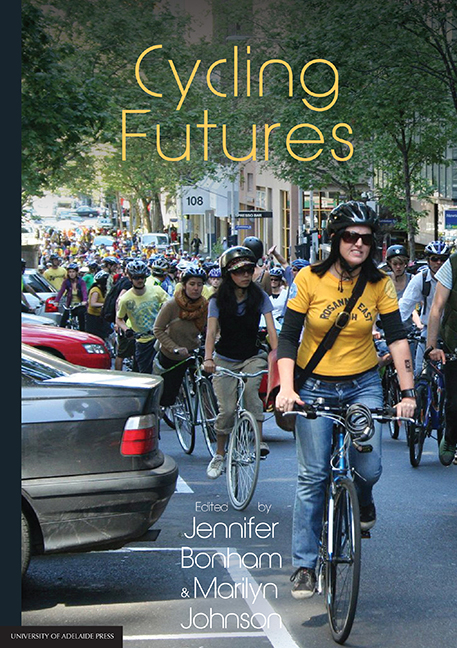Book contents
- Frontmatter
- Contents
- Preface
- Editors
- Contributors
- PART I Current challenges
- 1 Cycling: Bringing the future into the present
- 2 A glimpse at Australia's cycling history
- 3 Health benefits of cycling
- 4 An epidemiological profile of cycling injury in Australia and New Zealand
- 5 Faster than the speed of bikes
- 6 Economics of everyday cycling and cycling facilities
- 7 Cycling and sustainable transport
- 8 Cycle touring
- PART II Strategies for change
7 - Cycling and sustainable transport
from PART I - Current challenges
Published online by Cambridge University Press: 25 July 2017
- Frontmatter
- Contents
- Preface
- Editors
- Contributors
- PART I Current challenges
- 1 Cycling: Bringing the future into the present
- 2 A glimpse at Australia's cycling history
- 3 Health benefits of cycling
- 4 An epidemiological profile of cycling injury in Australia and New Zealand
- 5 Faster than the speed of bikes
- 6 Economics of everyday cycling and cycling facilities
- 7 Cycling and sustainable transport
- 8 Cycle touring
- PART II Strategies for change
Summary
Introduction
One of the most obvious benefits of more people choosing more sustainable transport options is the reduction in pollution emissions — and one such mode is the bicycle. However, the environmental benefits of more people walking or using the bicycle as their form of transport are far greater than just this. These environmental benefits of cycling have long been known, even in nations with extremely low levels of cycling participation. For example, a US study from the 1990s presented a convincing case for the superiority of cycling (and walking) in environmental terms. This study argued that ‘by far the greatest environmental benefit of bicycling and walking … is that they bypass the fossil fuel system to which the American economy has become addicted’ (Komanoff, Roelofs, Orcutt, & Ketcham 1993, p. 1).
This chapter reiterates many of the arguments about the environmental benefits of cycling, using recent data to support the case. In addition, the chapter introduces a discussion about happiness and personal connections with both the natural environment and with other people, which is often overlooked in discussions about ‘the environment’, yet can be seen as a vital part of a sustainable environment. In this chapter, using scale as the basis of division, we consider the broader environmental impacts of increasing bicycle use, starting with impacts on the individual, moving through to local communities and nations (specifically Australia and New Zealand), and ending with global impacts.
Personal impacts
There are a number of ways that cycling affects the personal environment of the individual. The most obvious is the health benefits that cycling provides through an increase in levels of physical activity and the increased levels of connectedness that come when people switch from cars to active modes of travel. These health benefits are covered by Rissel (Chapter Three, this volume) and do not need to be repeated in detail here. However, it should be noted that many of these health benefits are the direct result of physical exercise which can take place in a poor-quality environment where people using the bicycle can often be exposed to high volumes of traffic and associated pollution, as is often the case in our towns and cities.
- Type
- Chapter
- Information
- Cycling Futures , pp. 131 - 152Publisher: The University of Adelaide PressPrint publication year: 2015



